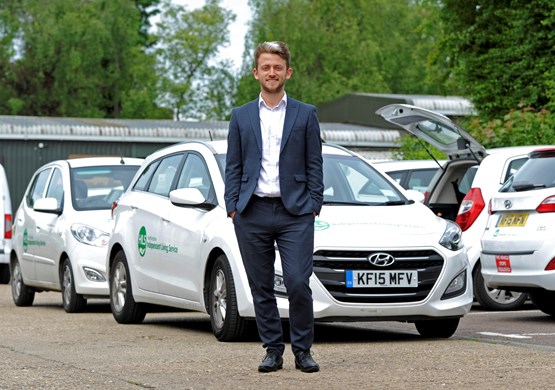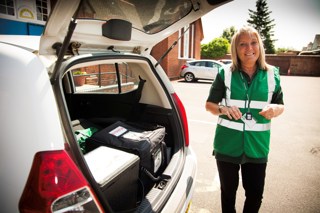Charlie Wren discusses how a safe-driving fleet focus fuelled by the introduction of telematics has helped cut collisions and protect residual values.
Safe driving policies, telematics and a greater engagement with drivers have delivered a 26% fleet insurance premium saving for Hertfordshire Independent Living Service (HILS).
The not-for-profit, charitable social enterprise, which provides meals on wheels and support services for thousands of elderly, frail or disabled people in Hertfordshire, operates a 68-strong vehicle fleet.
HILS began testing a telematics system at the end of 2014, before deciding to fit all of its vehicles with the technology in June 2015, after signing a three-year deal with Green Road.
“Almost instantly, we began to see an improvement in how vehicles were being driven,” says Charlie Wren (pictured), support services manager at HILS.
Despite a 50% increase in the size of its fleet in the past 18 months, resulting in a greater exposure to risk with more miles being driven, the organisation saw a 43% reduction in collision/damage incidents and a “significant” reduction in speeding ones.
The vehicles have a dashboard display which gives instant feedback through a traffic light system on driver performance. Drivers can also view their scores via an online portal or mobile phone application.
In addition, they are given access to a range of resources online to resolve any issues, such as harsh cornering or excessive braking which, says Wren, has helped them become more self-sufficient and take more responsibility for their actions on the road.
“We chose our telematics system because it was driver focussed and drivers can access the same information we can,” he explains.
“They can go online and have a look at the route they’ve just driven and see if there were any problems, where those problems were, what they were and what caused them.”
He continues: “It’s not distracting to the driver, but equally it isn’t silently recording their every move. We don’t want to create an Orwellian work environment. We just want people to know how they’re performing.”
There was an initial reluctance from some drivers to the system being installed but, says Wren, it is all about communication.
“We did initially provide drivers with a league table , but we had problems over whether somebody who was driving for 30 hours, and had three safety events, was better than somebody who drove 10 hours and had one,” he says.
“There were arguments both ways so we just decided to withdraw that feature.”
Good driver performance can still be rewarded, however. Wren explains: “We have quarterly awards for employees – the ‘Value Awards’ – and one of those values is conscientiousness so drivers can be nominated based on their driver score.”
A consistently poor safety score, speeding events or a combination of both will be investigated and, if deemed necessary, will be taken further.
One of the organisation’s charitable objectives however, is helping people back into work. Wren explains: “We often try to recruit people who find it hard to find work elsewhere.”
It means there are no predetermined restrictions on prospective employees who might drive in the course of their work.
“We deal with people on a case-by-case basis,” says Wren. “We don’t stipulate if you have this many points on your licence we won’t employ you.”
Nevertheless, for duty of care purposes licences are checked through a licence checking company at the start of employment and regularly thereafter.
Wren continues: “We would similarly employ somebody who has been driving for less than 12 months and we employ people under the age of 25 to drive; we don’t have any restrictions like that. We want to give them the opportunity, to trust people unless they give us reason to do otherwise.”
Naturally, that would suggest a lofty insurance premium to pay, with the organisation’s potential for greater exposure to risk. But, its use of telematics has more than helped keep that in check. Wren says: “We had a huge reduction in our insurance premium.”

Wren told Fleet News it had seen a 26% fleet insurance premium saving from 2015/16 to 2016/17, reduced car damage as a result of fewer collisions, which has cut vehicle downtime resulting in HILS providing an even more reliable service, and more accurate arrival times being given to customers as managers can check the exact location of drivers via the tele-matics service and drivers can advise of any delays.
Importantly, it now also has the ability to track lone drivers while they are working on behalf of HILS.
Wren joined the organisation in January 2015, initially as team leader for IT and stock before becoming support services manager, with responsibility for fleet, IT systems and facilities in July 2016.
He admits that if the organisation grows much larger they may consider a full-time fleet manager, but as it stands his time is split equally between his three areas of responsibility and he has an assistant who also fulfils a fleet role.
The 68-strong fleet, which is made up of 47 Hyundai i10s, nine Hyundai i30 Tourers, seven Nissan Micras, four Ford Transit vans and one Škoda Roomster, operates out of four sites in Hemel Hempstead, Letchworth, St Albans, and Ware. They deliver about 500,000 meals a year, seeing up to 2,000 people daily.
Wren says: “I spend a lot of time putting systems in place that better enable everyone in the organisation to help themselves and make things run as smoothly as possible.”
He has launched a ticket management system which is accessed online. Users are able to prioritise the ticket according to predefined guidelines which is sent electronically to a dedicated email address.
“Something which is considered critical is dealt with straight away,” he says.
It has also enabled Wren to monitor their own performance by assessing how fast they respond to problems and, now the system has been up and running for more than a year, it has given HILS a rich data stream for vehicles so any particular trends can be identified.
“It gives us a history of our cars,” he explains. “If somebody says the battery has just died then you can very quickly look through the history of that car and see if it has been raised before.”
The system’s introduction has been fuelled by a desire to give visibility and transparency to the organisation’s fleet.
“All the data I have access to is also available to everybody else,” he says. “If the team leader on site has a particular problem with one of their cars, as has happened before, they’ve raised the issue but also looked and seen this has been a problem before.”
The introduction of daily vehicle maintenance checks by drivers supplemented by weekly checks by nominated members of staff have also boosted the overall measurable standard of roadworthiness of cars and reduced breakdown risk.
Wren says: “When I introduced the daily checks they were more in-depth than they are now. For example, we used to get drivers to perform the 20 pence test on the tyres, but it was too involved, drivers became worried it was some sort of test and we were asking them to do more than they thought was reasonable.
“I decided to scale that back and instead introduce the more detailed weekly tests.”
The checks, combined with the improvement brought about the use of telematics, helped HILS achieve ‘Champion’ status through the Driving for Better Business scheme earlier this year.
They have also helped boost residual value (RV) perform-ance, important when vehicles are funded through hire purchase agreements.
Vehicles are kept for a maximum of three to four years and sourced through a local dealership. Wren says: “The vehicles have a five-year warranty so we like to move them on before that expires as it gives us a better resale value.”
There is no mileage threshold due to the local nature of the deployment of vehicles and the distances covered – about 10,000 miles per year.
Hire purchase is not a typical fleet funding mechanism, but Wren says that the business enjoys the “flexibility” it offers compared to leasing.
He explains: “We like to own the asset at the end of the agreement and we move quite fast as an organisation so having complete control is an advantage.
“When we leased our vehicles we found every little thing equated to a huge loss in the value of the vehicle, resulting in high end of contract charges.”
Hire purchase, according to Wren, removes the unforeseen costs, with HILS taking the RV risk instead.
“In the end, the walk-around checks and the use of telematics help us maintain the value of our assets,” he says. “We want to encourage people to treat our vehicles as if they were their own.”
Having achieved a range of improvements in the performance of the fleet in such a short time, Wren has no intention of resting on his laurels, however.
Operating a fleet which is currently powered by a mix of petrol and diesel, a detailed assessment of the potential of plug-in vehicles is next on the agenda.
“Electric vehicles fit our model really well, with none of our vehicles doing huge mileages,” says Wren. “It is something we want to do and could potentially save us money, as well as being good for the environment.”
Wren admits however, that in buying their vehicles they need to consider that higher initial outlay and the potential RV risk.
“It is now coming to the stage where more or less you can’t call it new technology; it’s tried, it’s tested and it works,” he says. “We’re just not quite there yet, but as more and more vehicles become available, it makes more sense.”

Service provides more than just meals on wheels
Hertfordshire County Council supported the establishment of Hertfordshire Community Meals as an independent, not-for-profit, organisation to deliver meals on wheels across the county back in 2007.
The service began with one site in Letchworth, two vehicles, and a team of volunteers delivering meals in the north of the county.
By 2013, the remaining nine districts in the county transferred their clients to Hertfordshire Community Meals and three more sites were established across the area in Hemel Hempstead, St Albans and Ware.
Hertfordshire Community Meals underwent a rebrand in April 2015, and began operating as Hertfordshire Independent Living Service (HILS) to reflect it was now doing more than just delivering meals.
Other services include: community transport, security services and dementia support.
A charitable social enterprise, it has a contract from Hertfordshire County Council to deliver meals on wheels on the council’s behalf, and receives some money from other organisations.
It only uses paid staff to deliver its meals, while volunteers provide support to deliver its other services.
A number of HILS’s staff have found it difficult to work elsewhere for a range of reasons but, with training and support, the organisation has helped them to thrive in the workplace.





















Login to comment
Comments
No comments have been made yet.